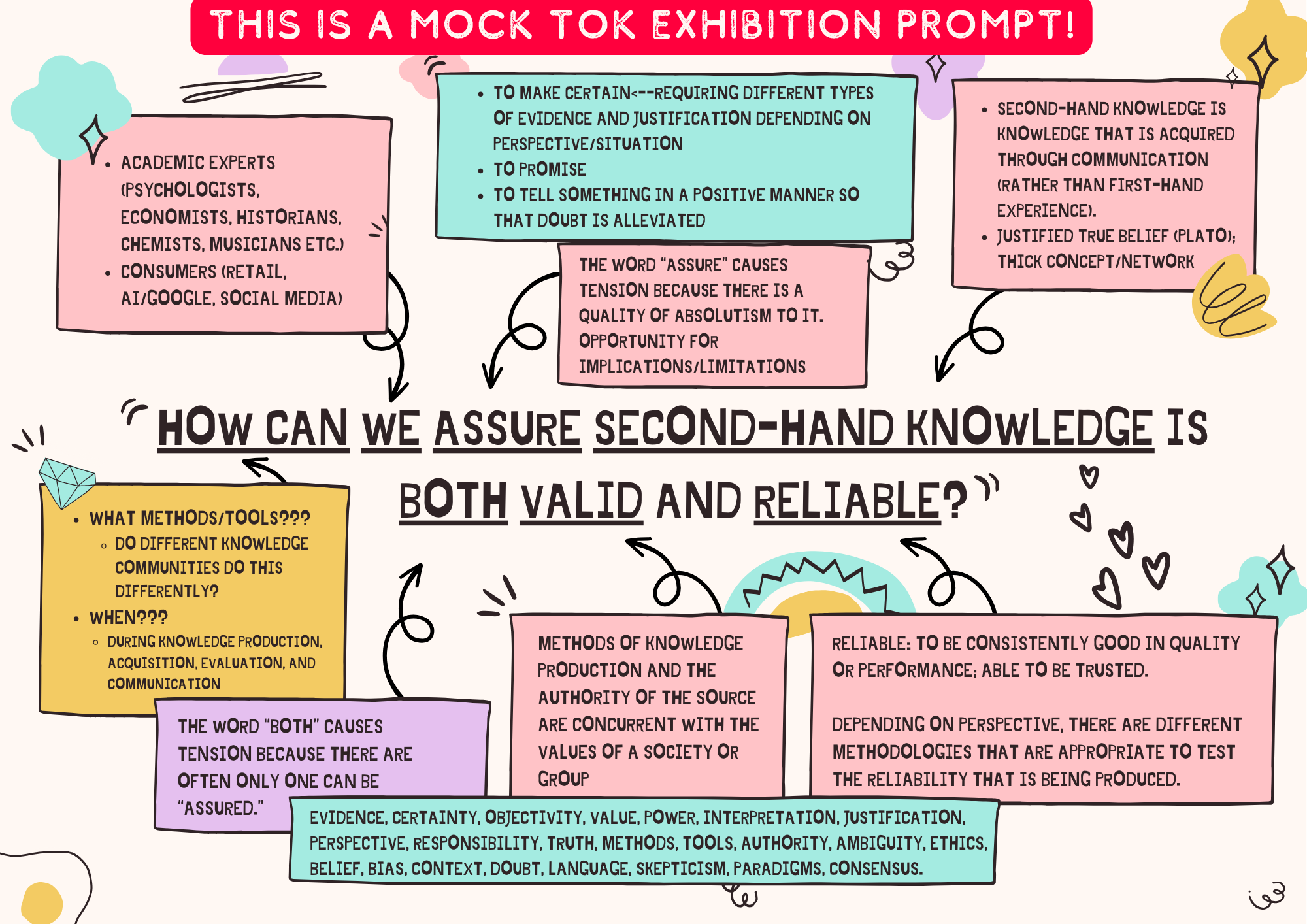The Art of Parsing: Navigating TOK Exhibition Questions
4 minute read
20 minute activity
This mind map is from a mock TOK Exhibition. Don’t mistake this for an official prompt.
Let’s parse those TOK exhibition prompts! They're just like any other knowledge question you've used in class before – so don't let the pressure of this being an INTERNAL ASSESSMENT create a mental block.
Parsing knowledge questions is a skill that requires you to dissect and understand the question's deeper meaning. This process involves examining each word and phrase, understanding its context, and relating it to knowledge. When you are considering a TOK exhibition prompt, your first step should be to break it down: What are the key terms? What do they mean in the context of TOK? Is the question about producing, acquiring, communicating, or evaluating knowledge?
Again, don’t feel overwhelmed! I’m going to walk you through my tried-and-true method.
Grab a piece of paper and some markers. (You will want to color code this, or things will be very confusing at the end!) Now, let’s make a mind map.
Step 1:
Write the prompt in the center of the page.
Step 2:
Identify why this prompt is considered a “knowledge question.”
For some prompts, that’s easy: it literally uses the word “knowledge.” But for seven out of the thirty-five prompts, “knowledge” is implied. If you’ve chosen one of those seven prompts, you’ll need to understand how “knowledge” is implied. For example, if the prompt asks about a “claim” – you know that in TOK, a “claim” means “a statement of knowledge.” You might want to add the word “knowledge” before the word “claim” for this parsing activity, so that you don’t get confused.
Step 3:
Look for words that indicate the type or types of knowledge that could be explored with this prompt. You’ve studied the different ways that knowledge is categorized and classified. Take a moment to list out all the ones that apply to this prompt, e.g. knowledge by acquaintance, practical knowledge, tacit knowledge, academic knowledge, etc.
Step 4:
Investigate the knowledge treatment stated or inferred in the prompt. By this, I mean, is this question asking about the production, acquisition, communication, or evaluation of knowledge? Could it be asked about more than one of these treatments? Write down all that apply to the prompt.
Step 5:
Think about communities of knowers.
One of the biggest mistakes I see students make is not considering the perspective (community of knowers) around which they are framing each commentary. Students who pick highly personal objects often run into issues as they are tempted to make generalized (and often problematic) claims about how “people” react to the world around them. The trick – even with those very personal objects – is to identify the community scope, perspective, methods/tools, and ethics. But I’m getting ahead of myself, and this belongs in a future post.
For now, we are just trying to identify all the different communities of knowers/perspectives you imagine would connect well with this question. These groupings could be around culture, age, nationality, profession, discipline, expertise, and much more.
Take a moment to list out all the communities you can imagine in regards to this prompt. For prompts that use the word “we” or “our,” this step may be more obvious, but it is necessary for all the prompts, and it is important that you come up with a list that is quite diverse.
Step 6:
Identify exactly what the prompt is asking you to do. Is it an evaluative question? Is it a question that requires you to unpack different relationships? Is it a question that needs you to identify implications?
Make sure you know what the prompt requires of you.
If the prompt asks “does,” “are,” “should,” or “is,” it wants you to answer yes or no (although you can answer yes in one commentary and no in another).
If the prompt asks you “how,” it wants you to outline exactly how.
If the prompt asks “what,” it is looking for a list.
If it is asking “why,” it wants an evaluation of each perspective.
If it asks “to what extent,” it is looking for a measurable answer.
If it asks “who,” it wants to know who.
I know the above list seems very silly, but this is the most common error I see. Students hyperfocus on the TOK concepts they’ve identified, but they don’t actually answer the question because they’ve skipped this step in the parsing of the question.
Step 7:
Look for “tension” or “conflict” words; words like “good,” “adequate,” “own,” or “important,” and many others. These are words that will require you to define them within the context of the object and the community of knowers’ perspective. It is worth taking time now to bullet point all the different ways you can already imagine these words could be interpreted.
Step 8:
Which parts of the knowledge framework is your prompt focuses on? Scope? Perspective? Methods and tools? Ethics? Write them down.
Step 9:
Which12 TOK concepts are most obviously connected to the prompt? What other TOK theories or concepts are obviously connected? Write down all these possibilities.
Conclusion
Your mind map should be a beautiful mess of ideas.
Now that you’ve developed your understanding of your selected prompt and you’ve unpacked many of its possibilities, it is time to go on an object hunt. This could be physical (walk around your house, browse through your notes from your other 6 subjects) or it could be a mental reflection. Start writing down all the objects that come to mind. Again, don’t self-censor. List and list and list. The more ideas you have now, the more you can evaluate to find a strong trio of objects that complement each other while offering you the space to create different textured commentaries.
Good luck parsing those prompts! You can do this.


